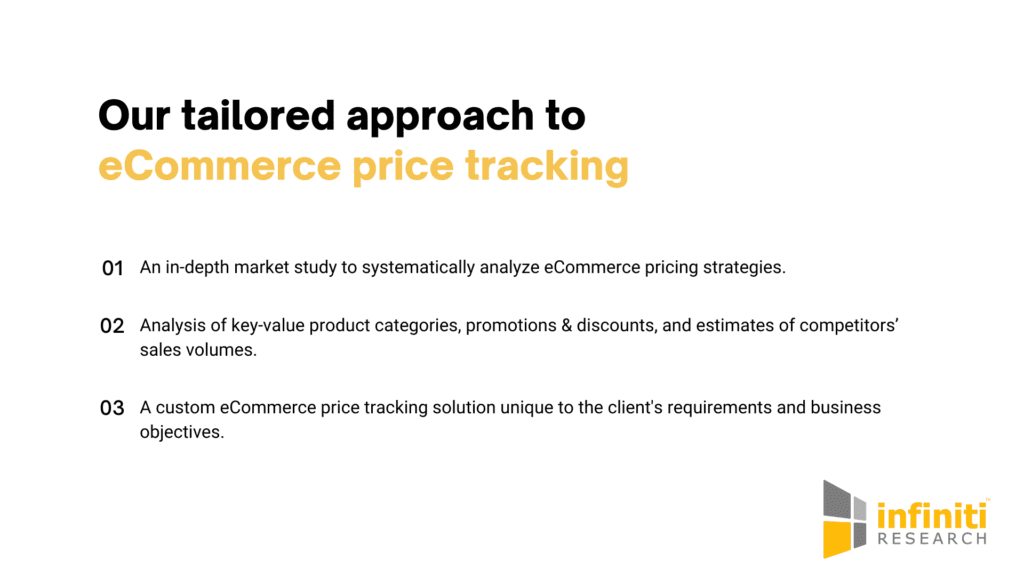With an extensive inventory exceeding one million SKUs, the retailer recognized the need for an effective price tracking solution to remain competitive in a rapidly evolving market. The collaboration aimed to address challenges related to price visibility, competitor analysis, and optimal pricing strategies. By leveraging our expertise in data analytics and market intelligence, the retailer sought to enhance its pricing decisions, improve profitability, and better respond to market dynamics.
Ecommerce Price Tracking: Why is it important?
eCommerce price tracking plays a crucial role in enhancing both consumer price perception and profitability. Many retailers sell about one-fifth of their product offerings at low prices to maintain a competitive edge. These products often termed ‘key-value product categories,’ are usually best-sellers or high-demand SKUs whose prices play a crucial role in determining market success.
Key-value products can account for more than seventy percent of an average retailer’s revenue but generate only half their profits. However, identifying key-value product categories is as tricky as setting and validating prices for other products because of the sparse historical data and high competition. Ecommerce price tracking helps retailers address these challenges by offering precise pricing recommendations and insights into competitors’ pricing strategies.

Client’s Background
The client is a well-established European retailer operating in the non-food segment, offering a diverse range of products. With a vast SKU portfolio, they cater to various consumer needs across multiple markets.
Business challenge
Inadequate Price Monitoring: The retailer struggled to track competitor prices effectively across numerous platforms.
Market Fluctuations: Rapid changes in market conditions made it challenging to adapt pricing strategies promptly.
Data Management Issues: Handling large volumes of pricing data from various sources created scalability challenges.
Competitive Pressure: Intense competition necessitated agile pricing tactics to maintain market share.
Profitability Concerns: Inefficient pricing strategies led to reduced margins and sales performance.
The retailer faced significant hurdles in managing pricing dynamics, which hindered their ability to remain competitive and maximize profitability.
Inadequate Price Monitoring: The retailer struggled with effectively tracking the prices of over one million SKUs across numerous competitors and platforms. This complexity made it difficult to maintain an accurate and up-to-date understanding of market pricing dynamics, which is essential for competitive positioning.
Market Fluctuations: Rapid changes in market conditions, influenced by factors such as inflation and competitor pricing strategies, created challenges in adapting pricing in real-time. The retailer needed a system that could respond quickly to these fluctuations to avoid losing market share.
Data Management Issues: Handling vast amounts of pricing data from various sources posed significant scalability challenges. The existing systems were often unable to process this data efficiently, leading to delays and potential inaccuracies in price comparisons.
Product Matching Difficulties: Many pricing intelligence solutions struggled with accurately matching products at the SKU level, especially when identifiers like UPCs or EANs were missing. This limitation hindered the retailer’s ability to conduct precise price comparisons and make informed pricing decisions.
Compliance and Data Quality Assurance: Ensuring compliance with website policies while extracting data was a concern, as legal issues could arise from improper data scraping practices. Additionally, maintaining data accuracy and integrity was critical, as inconsistent or outdated information could lead to misguided pricing strategies.
Get in touch with our competitive intelligence experts to gain complete access to our comprehensive portfolio of ecommerce price tracking solutions.
Solutions
We implemented several strategic solutions to address these challenges:
-
Real-Time Price TrackingDeveloped a robust system for monitoring competitor prices across multiple e-commerce platforms.
-
Data Analytics FrameworkEstablished a scalable data processing pipeline for analyzing large volumes of pricing data.
-
Competitor InsightsProvided actionable insights into competitor pricing strategies and market trends.
-
Pricing Optimization ToolsImplemented tools that facilitated dynamic pricing adjustments based on real-time data.
-
Compliance MechanismsEnsured adherence to legal standards while extracting data from various sources.
Business Impacts
Enhanced Pricing Accuracy: Improved accuracy of pricing decisions through real-time data insights.
Increased Profit Margins: Achieved a 15% increase in profit margins due to optimized pricing strategies.
Faster Market Response: Reduced response time to market changes by 30%, allowing for timely adjustments.
Competitive Advantage: Gained significant competitive edge through comprehensive price monitoring capabilities.
Improved Sales Performance: Notable growth in sales volume attributed to more effective pricing tactics.
Enhanced Pricing Accuracy: The implementation of real-time price tracking allowed the retailer to make more informed pricing decisions. By continuously monitoring competitor prices, the retailer could adjust its own pricing strategies to remain competitive, leading to improved pricing accuracy across their extensive SKU portfolio.
Increased Profit Margins: With optimized pricing strategies informed by real-time data, the retailer achieved a notable increase in profit margins—estimated at around 15%. This was primarily due to the ability to identify the optimal price points that balanced customer demand with profitability, ensuring that products were neither overpriced nor underpriced.
Faster Market Response: The retailer significantly reduced its response time to market fluctuations by approximately 30%. This agility allowed them to quickly adapt to competitor price changes or shifts in consumer demand, ensuring they could capitalize on opportunities and mitigate potential losses.
Competitive Advantage: By leveraging comprehensive price monitoring capabilities, the retailer gained a substantial competitive edge in the market. The ability to respond swiftly to competitor pricing strategies enabled them to attract price-sensitive customers and retain existing ones, enhancing their market position.
Improved Sales Performance: The strategic adjustments made possible by MIDAS’s solutions led to a marked increase in sales volume. By aligning prices more closely with market conditions and consumer expectations, the retailer was able to boost customer satisfaction and loyalty, resulting in higher sales figures.
Valuable Market Insights: The data collected through price tracking provided the retailer with invaluable insights into overall market trends and consumer behavior. This information not only informed pricing decisions but also guided inventory management and promotional strategies, further enhancing operational efficiency.
Conclusion
This case study demonstrates how Infiniti Research successfully transformed the European retailer’s approach to price tracking and optimization. By implementing advanced monitoring systems and analytical tools, the partnership led to improved decision-making capabilities and enhanced business performance. The results underscore the importance of leveraging market intelligence in today’s dynamic e-commerce landscape.
 Twitter
Twitter





